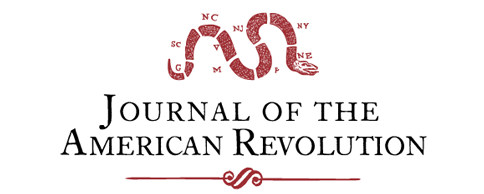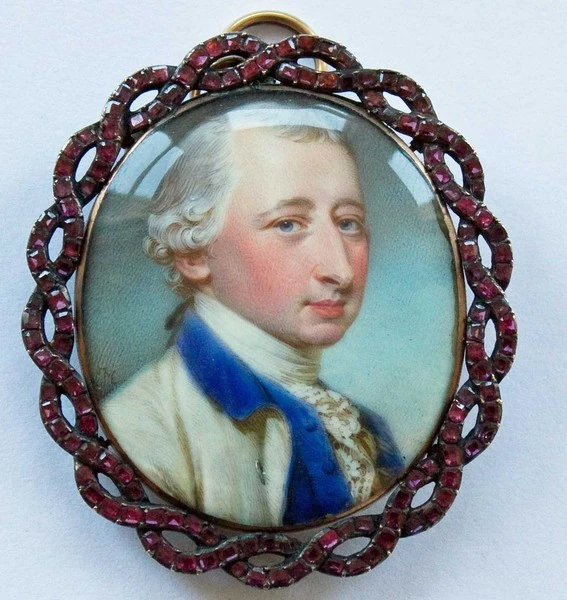On February 6, 1778, the American colonies signed a Treaty of Amity and Commerce and a Treaty of Alliance with the country of France. The former treaty recognized the absolute sovereignty and independence of the colonies and established commercial rights in direct opposition to England’s Navigation Acts; the latter guaranteed financial and military support. On March 13, the Marquis de Noailles, the French Ambassador to the Court of St. James, informed the Court that France had signed the two treaties. This did not surprise many at the Court. On January 6, Lord William Stormant, the Court’s Ambassador to France, had predicted the alliance,[1] and on January 20, 25 and 26, Lord George Germain, the Secretary of State for the American Department, received updates on the negotiations from James Hutton, his spy in Paris.[2] On February 18, Germain sent orders to Admiral Richard Howe, Naval Commander of the British Fleet in American waters: he was to destroy all of the shipyards in and all of the ships belonging to Connecticut and New Hampshire. [3] On the 20th, Stormont informed Lord Weymouth, the Secretary of State for the Southern Department, that he was certain war between France and England would soon break out. [4] On March 6, Lord Sandwich, First Lord of the Admiralty, submitted a report to Prime Minister Lord Frederick North’s cabinet on the number and location of all French ships of the line; there were twenty-one at Brest, the French port on the western tip of Brittany on the Atlantic Ocean and twelve at Toulon, a French port near the mouth of the Rhone River in the Mediterranean. [5] These numbers were important because if the treaties were signed, war would then be declared between the two countries and England could be fighting on two fronts—in the English Chanel and off the coasts of North America.
On March 15, two days after the Marquis delivered copies of the treaties, Sandwich submitted a second report to North’s Cabinet on the number and location of all English ships of the line, “Our whole force at home at present in commission consists of 55 lines of battle and 46 frigates . . . of these 40 of the line may be considered as applicable to immediate service, the other 15 are getting forward, and if the men can be had may soon be ready.” [6]
Out of the forty active ships, twenty were assigned to the Channel for “defense of the kingdom” and twenty were assigned to America to “protect our distant.”[7] Sir Augustus Keppel was made commander of the Home Fleet the next day. The Home Fleet had four responsibilities: first, to blockade the French port at Brest; second, to secure the Channel; third, to prevent France (or Spain) from dispatching an expedition overseas; and to serve as a strategic reserve, that is, to be able to send squadrons to support overseas offensives.[8] In Lord Sandwich’s mind, from the English Channel “all our exterior efforts are derived.”[9]
Lord North’s cabinet held meetings on March 14, 15 and 18. At the meetings, the following were discussed: homeland defense, the impact on the colonies, protection of the West Indies islands, and how to keep the Toulon and Brest fleets from joining up. It was the fourth topic that was given the greatest amount of attention. If the two French fleets joined up, they would have as much firepower as Keppel’s fleet, and if the Spanish fleet in Cadiz were to join the two French fleets, the British fleet would be significantly out manned and out gunned. [10]
On March 19, Secretary of State Weymouth learned that French Admiral D’Estaing was on his way to Toulon to take command of the fleet.
On March 21, Germain sent secret instructions to Gen. Henry Clinton, the commander in chief of the army in North America. He was to send a force of 5,000 men and four ships of the line to take the French garrison on the island of St. Lucia, send a force of 3,000 men to strengthen the garrisons at St. Augustine and Pensacola in Florida, and to withdraw from the city of Philadelphia and take his forces to New York. If he could not hold New York, he was to reinforce the garrison at Rhode Island and take the remainder of his forces to Halifax where they were to protect Nova Scotia and Newfoundland.[11] The instructions did not reach Clinton, who was in Philadelphia, until May 9.
On April 4, Sandwich made his position clear at the Cabinet meeting:
that it will be very unsafe to leave England and Ireland without a much larger force than Admiral Keppel’s 20 Ships of the Line for this defence. The additional force that I think necessary must be determined by the force that France and Spain have ready for sea, as our principal object must be our defence at home; when that is secured, detachments may be made as exigencies require[12]
Even though Keppel and Sandwich opposed Germain’s position, they did not totally agree about how to manage the Home Fleet. Sandwich believed that once the fleet was large enough to repel any attack, it could detach or disperse. Keppel believed that at no time should ships from the fleet ever be detached and /or dispersed. At this point, however, they both believed that D’Estaing was going to take his fleet to Brest, join the Comte d’Orvilliers’ fleet, then together attack England. There were two options: D’Estaing was sailing for the colonies or he was sailing for Cadiz to join the Spanish fleet. The obvious solution was not to let D’Estaing leave the Mediterranean. In other words, English ships of the line should engage his fleet before it passed through the Straits of Gibraltar. Unfortunately, to do this Sandwich would need to send ships from the Channel fleet, thus reducing its ability to defend England in the event that Comte d’Orvilliers and his fleet at Brest chose to attack.
On April 7, ten additional British ships of the line were ready for assignment. Some had returned from cruise duty, others had finished repairs or had filled their quota of men. One was sent to America and nine remained in the Channel. This gave Admiral Keppel twenty-nine ships of the line.[13] On the 13th, unbeknownst to the cabinet, D’Estaing set sail from Toulon.
When Keppel took the position of commander of the Home Fleet he informed the King George that he was against separation and dispersal. On April 16, he repeated his position to Sandwich:
In regard to the great [Home] fleet, the consideration of its being the bulwark and real safety of these dominions, I cannot but think that in every view of it, it should be preserved in force superior to the enemies if possible, and depend upon good intelligence for adopting any separation . . . I must repeat that it would be unwise to separate the great fleet by detachment.[14]
On the 20th, Sandwich, rather than detach a squadron of ships to Gibraltar, sent one ship, the Proserpine, to see what course D’Estaing would take once he left the Mediterranean.[15]
On April 25, Sandwich ordered some ships of the line from the Channel fleet to escort reinforcements for Gibraltar; they were to go only as far as the island of Ushant which was located at the southwestern edge of the Channel. They were to remain there for one month; their job was to stop D’Estaing’s fleet if it was headed for Brest. Before the ships departed, their plans changed. The Cabinet had received a cipher dispatch dated April 12 from the British charge d’ affaires stationed in Turin. He said that D’Estaing had nine ships of the line and six frigates at Toulon; he would be joined by three more ships of the line any day and would set sail on the 20th—not the 13th. Also, the British Minister at the Hague was told by some Amsterdam bankers that the Toulon fleet sailed with nine months of provisions.
On April 27, Germain wrote to North; he was convinced that D’Estaing was headed to the American colonies
where it will be joined by all the marine force of the rebellious provinces, and in that case will be able to attack and destroy our fleet on those seas and possess themselves either of Halifax, Philadelphia, or Quebec, if some immediate step be not taken by sending a strong squadron to reinforce Lord Howe and prevent the fatal consequences which may follow from the French having an avowed superiority at sea upon the cost of North America.[16]
On the 28th, King George wrote to North. He enclosed a copy of the letter that Keppel had sent him shortly after he took the position of admiral of the Home Fleet. Near the end of the letter, Keppel had written, “If the destination of the Toulon fleet can be ascertained, suppose West or East, equal force will on course be sent close upon them.”[17]
On the 29th, the Cabinet received intelligence that D’Estaing had sailed for the colonies. Germain tried one more time to change Sandwich’s opinion.
The fate of the country evidently depends upon the preventing the Toulon Squadron from acting with success against our Fleet and Army and our possessions in North America. . . . What security can we give our fisheries; what protection can we grant Jamaica and the Leeward Islands? . . . at least twelve ships of the line should be now immediately detached to Halifax; and if the enemy should not be at that port to pursue and attack them in whatever station they may have taken. . . . A frigate should be immediately dispatched advising the Commanders-in-Chief of the attack they are to expect and of the detachment made for their defense . . . in all military operations of importance some risk must be run, and it is more meritorious to suffer in a vigorous ad necessary exertion of our forces, than to remain inactive and tamely to submit to the loss of our detached fleets, armies and distant possessions[18]
Sandwich did not change his opinion, but was overruled near the end of the meeting when the cabinet decided on a course of action. With the King’s assent, thirteen ships of the line were ordered to sail for the colonies with the sole purpose of locating and destroying D’Estaing’s fleet. On the 30th, Rear-Admiral Hyde Parker was ordered to meet up with Vice-Admiral John Byron at Plymouth and to sail under him to the colonies as soon as possible.[19] Unfortunately, his ships at Plymouth were not provisioned. It was two weeks before he could set sail from Plymouth. Because of the delay, his destination was changed; instead of sailing for Halifax, he was to sail for New York City.
On May 4, Germain asked Sandwich for a frigate to carry the warning dispatches to Clinton and Admiral Howe; Sandwich said one could not be spared. Germain then sent the dispatches aboard the packet boat Grantham. They would not reach Howe until June 29 and Clinton on July 1.
On May 7, Sandwich wrote to North; he wanted to know North’s “mature consideration that so momentous an affair demands.”[20] Sandwich was now less concerned about D’Estaing‘s fleet and more concerned that the French fleet at Brest and Spanish fleet at Cadiz might join up and while D’Estaing was sailing to the colonies, the combined fleet would attack the Channel fleet. North believed that there was enough information to indicate that D’Estaing was enroute to the colonies. The next day North informed Sandwich that he had shared his position with all of the members of the cabinet still in London: Germain, Weymouth, Lord Dartmouth, the former Secretary of State for the American Department, and Lord Gower, the President of the Council. Each of them agreed that Byron should continue with this his orders to pursue D’Estaing.[21] D’Estaing was further assisted on May 13 when Germain told Byron not to depart Plymouth;[22] the Cabinet wanted to wait until Proserpine returned. Also on this day, the cabinet received news that D’Estaing’s fleet had been sighted of the coast of Algeria on April 28.
Germain, North and Sandwich were again unaware that D’Estaing and his Toulon Fleet did not pass through the Staits of Gibraltar until May 16, just about when Byron should have been departing Plymouth. The Cabinet continued to receive unreliable information until the first week of June when Proserpine arrived at Falmouth. The captain of the ship said D’Estaing’s fleet was seen inside the Straits of Gibraltar on May 16 and he followed the fleet westward for two days. Byron was ordered again to depart Plymouth on June 7, but was not able leave until June 9 because of south-west winds. Shortly into the voyage, Byron’s fleet had to deal with a number of storms; the result was a scattered fleet with many damaged ships. On August 8, Byron’s flagship, without any other ship nearby, sighted D’Estaing’s fleet near Long Island. He had no choice but to change his course and sail for Halifax.
The British embarkation at Philadelphia was finished on June 18 but the ships did not reach the mouth of the Delaware River until June 28. If Byron had departed on April 30, he probably would have arrived in late June and with Lord Howe’s four ships of the line and two frigates been able to overcome D’Estaing’s fleet.[23]
[1] “Lord North to King George, Jan. 6, 1778,” in The Correspondence of George III from 1760 to 1783, John Fortescue, ed. (London:1928), 4: no.2149.
[2] Samuel F. Bemis, “British Secret Service and the French-American Alliance,” American Historical Review, XXIX (1924), 474-495.
[3] “Germain to Sir William Howe, Feb. 18, 1778,” and “Germain to Sir Henry Clinton, Mar. 8, 1778,” British National Archives, Colonial Office Papers, CO 5/95.
[4] “Stormont to Weymouth, Feb. 20, 1778,” The Private Papers of John Earl of Sandwich, First Lord of the Admiralty, 1771-1782, eds., G.R. Barnes and J.H. Owen (London: Navy Records Society, 1932-1938), 1:343-44.
[5] William B. Willcox, Portrait of a General Sir Henry Clinton in the War for Independence (New York: Alfred A. Knopf, 1964), 212-13.
[6] The Correspondence of King George III, 4: no. 2218.
[7] “State of the Forces at Home, March 1778,” The Private Papers of John Earl of Sandwich, 2:19-20.
[8] Piers Mackesy, The War For America (Lincoln, Nebraska: University of Nebraska Press, 1964), 192.
[9] The Private Papers of John, Earl of Sandwich, 1:333-35.
[10] In 1733 and again in 1743, France and Spain signed the Pacte de Famille. It was an agreement between the two Bourbon Houses that if one was attacked, the other would come to its defense.
[11] “Germain to General Henry Clinton, March 21, 1778,” in The Private Papers of John, Earl of Sandwich, 1:369.
[12] “Lord Sandwich’s Opinion, 4 April 1778,” ibid., 2:22-23.
[13] The Correspondence of George III, 4: no.2324.
[14] “Keppel to King George, April 1778,” ibid., 4:2312; “Keppel to Sandwich, April 16, 1778,” The Private Papers of John, Earl of Sandwich, 2:30-31.
[15] Little did they know that Proserpine would not return to England with information until June 2.
[16] “Germain to North, April 27, 1778,” The Correspondence of George III, 4: no. 2316.
[17] “King George to Lord Sandwich, April 29, 1778,” The Private Papers of John, Earl of Sandwich, 2:38-39.
[18] “Germain’s Protest, April 29, 1778,” and ”Cabinet Minute, April 29, 1778,“ Manuscripts of Mrs. Stopford-Sackville (Ann Arbor, MI: William L. Clements Library, 1904-10), Appendix, Part iii.
[19] Ibid. On May 3, Rear-Admiral Hyde Parker was ordered to take his eleven ships of the line to Plymouth and serve under Vice-Admiral Byron. Byron had two ships of the line. “To Vice-Admiral Byron, May 3, 1778,” British National Archives, Admiralty Office, AO 2/104 (Orders and Instruction) and AO 2/1335 (Secret Orders and Letters).
[20] “Sandwich to North, May 7, 1778,” The Private Papers of John, Earl of Sandwich, 2:49-50.
[21] “North to Sandwich, May 8, 1778,” ibid., 2:53-54.
[22] “Sandwich to Weymouth, May 13, 1778,” ibid., 2:58; “Germain to Vice-Admiral Byron, May 13, 1778,” Manuscripts of Mrs. Stopford-Sackville, Appendix, Part iii.
[23] “Lord Howe to Philip Stephens, January 5, 1778, regarding disposition of ships under Howe,” British National Archives, Admiralty Office Papers, AO 1/488.








One thought on “1778 Naval Strategy: French Actors and British Reactors”
Great piece! I enjoyed the April 27 Germain letter:
“… where it will be joined by all the marine force of the rebellious provinces, and in that case will be able to attack and destroy our fleet on those seas and possess themselves either of Halifax, Philadelphia, or Quebec, if some immediate step be not taken by sending a strong squadron to reinforce Lord Howe and prevent the fatal consequences which may follow from the French having an avowed superiority at sea upon the cost of North America”
as the Virginia State Navy is one of my areas of research.